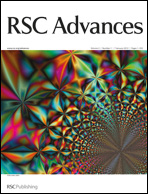Removal of SO2 by a mixture of caprolactam tetrabutyl ammonium bromide ionic liquid and sodium humate solution†
Abstract
A novel flue gas desulfurization process, which applies a mixture of caprolactam tetrabutyl ammonium bromide ionic liquid ([CPL][TBAB] IL) and sodium humate (HA–Na) solution, was proposed. This study relates to the SO2 absorption efficiency and products of removing SO2 in a bubbling reactor, especially the effect of recycling the mixed aqueous solution. The experimental results indicate that the maximum absorption efficiency of SO2 approaches almost 95%, thereby allowing this mixed solution to be used repeatedly up to 5 cycles. However, the initial pH of the mixed aqueous solution, which was prepared by recycling the mixed solution, dropped from 10 to 7.5 while the cycle number increased from 1 to 5. Meanwhile the final pH of the mixed aqueous solution remains almost a constant (2.1) after the completed absorption reaction. The desulfurization time and the absorption amount of SO2 decreased as the cycle number rises. The FT-IR spectroscopic and XPS results of desulfurization product show that humic acid (HA) can be sulfonated to some extent in this process. This finding provides a testimony that HA can react with sodium bisulfite in a Michael addition reaction, and [CPL][TBAB] IL can play a role in this reaction as a catalyst. The chief by-product is compound fertilizer consisting of sulfonated HA and sulfates.


 Please wait while we load your content...
Please wait while we load your content...